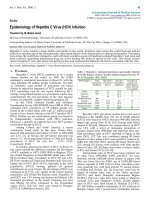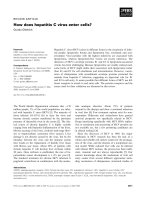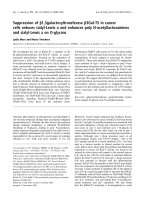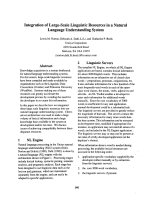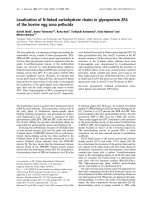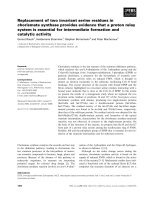Báo cáo khoa học: "Occurrence of Hepatitis C Virus infection in type 2 diabetic patients attending Plateau state specialist hospital Jos Nigeria" doc
Bạn đang xem bản rút gọn của tài liệu. Xem và tải ngay bản đầy đủ của tài liệu tại đây (214.6 KB, 5 trang )
BioMed Central
Page 1 of 5
(page number not for citation purposes)
Virology Journal
Open Access
Research
Occurrence of Hepatitis C Virus infection in type 2 diabetic patients
attending Plateau state specialist hospital Jos Nigeria
James A Ndako*
1
, Georgebest O Echeonwu
1
, Nathaniel N Shidali
2
,
Iliyasu A Bichi
1
, Grace A Paul
1
, Ema Onovoh
1
and Lilian A Okeke
1
Address:
1
Department of Virology, Federal College of Veterinary and Medical Laboratory Technology, Vom, Nigeria and
2
Department of Medical
Laboratory Sciences, University of Maiduguri, Nigeria
Email: James A Ndako* - ; Georgebest O Echeonwu - ;
Nathaniel N Shidali - ; Iliyasu A Bichi - ; Grace A Paul - ;
Ema Onovoh - ; Lilian A Okeke -
* Corresponding author
Abstract
Background: Glucose intolerance is observed more in patients with HCV infection compared
with control subjects with liver disease, Initial studies suggested that Hepatitis C virus infection may
be an additional risk factor for the development of diabetes mellitus. This study was therefore
carried out to determine the correlation of HCV infection and diabetes.
Methods: Three hundred (300) confirmed type 2 diabetic patients were screened for hepatitis C
virus antibodies at the Plateau state specialist hospital, Jos, using Grand diagnostic test strip.
Questionnaire comprising of age, sex, family history on diabetes, duration of disease and marital
status were issued to subjects.
Results: Overall result showed that the prevalence rate of HCV infection was 33(11%). In
response to diabetic status, females subjects had a higher prevalence of 178(59.3%) compared to
males 122(40.7%). Those aged 47–57 recorded the highest seroprevalence 10(30.3%) to the
Hepatitis C Virus, while Patients without family history of diabetes showed a higher seroprevalence
of 13(39.4%). Subjects who never had any blood transfusion recorded a prevalence rate of
6(18.2%). Marital status showed no significant difference [(P = 0.275; P.0.05)]. Considering duration
of developing diabetes, patients within the range of 1–10 years diabetic status recorded the highest
prevalence rate 25(75.8%) compared to other ranges considered.
Conclusion: This study hence, suggests a relatively strong association between HCV infection and
diabetes, this therefore call for an urgent approach strategy in the control and management of this
disease of the endocrine system.
Background
Various epidemiological studies have suggested that hep-
atitis C virus (HCV) infection is a risk factor for the devel-
opment of diabetes mellitus (DM) type 2. The etiological
factors were initially thought to be cirrhosis but further
studies differentiating between HCV and hepatitis B virus
Published: 8 July 2009
Virology Journal 2009, 6:98 doi:10.1186/1743-422X-6-98
Received: 25 April 2009
Accepted: 8 July 2009
This article is available from: />© 2009 Ndako et al; licensee BioMed Central Ltd.
This is an Open Access article distributed under the terms of the Creative Commons Attribution License ( />),
which permits unrestricted use, distribution, and reproduction in any medium, provided the original work is properly cited.
Virology Journal 2009, 6:98 />Page 2 of 5
(page number not for citation purposes)
(HBV) related infection have shown that patient with
HCV infection have a higher prevalence of Diabetes mel-
litus type-2 [1].
Pathogenesis
Most persons who become infected with HCV viraemia
persist, accompanied by variable degrees of hepatic
inflammation and fibrosis. Earlier studies of chronic HCV
infection suggests that only a small number of hepato-
cytes become infected, but more recent studies suggest
that 50% or more harbor the virus[2]. HCV is most effi-
ciently transmitted through transfusion of infected blood,
transplantation of infected organs, and sharing injection
drug equipment [3].
Diagnosis
The diagnosis of HCV infection can be made by detecting
either anti-HCV or HCV RNAof anti-HCV is recom-
mended for routine testing of asymptomatic persons and
should include use of both enzyme immunoassay (EIA)
and supplemental or confirmatory testing with an addi-
tional, more specific assay. Use of supplemental antibody
testing (i.e., RIBA) for all positive anti-HCV results of EIA
is preferred, particularly in settings where clinical services
are not provided directly [4].
Aim
Type 2 diabetes is a debilitating disease condition espe-
cially in people above 30 years of age and this may evolve
throughout their life-span. Hence, the co-infection of type
2 diabetes and HCV has been established to worsen these
condition, with this scenario it has become very necessary
for a screening exercise to determine the prevalence rate of
HCV among diabetic patients so as to increase awareness
of the populace and health practitioners on the dangers of
the co-infectious state of this virus with diabetes.
Materials and methods
Our study was carried out according to the ethical stand-
ards for human experimentation. After explaining the aim
of the study and the possible need for blood tests, written
informed consent were obtained and ethical clearance
granted.
Subjects
The subjects included in this research project were 300
known type 2 diabetic patients attending the hospital for
check-ups.
Study Location
The study was carried out at the plateau state specialist
hospital, Jos South local government area, Plateau state.
Sample Collection
3 ml of blood was collected from each patient by vene-
puncture using sterile syringes and needles into a sterile
container with a screw cap. The blood was allowed to clot,
and the sera samples were dispensed into a dry clean cry-
ovial and stored at -20°c prior use.
Method of Assay
The grand diagnostic rapid test kit was used to analyze the
samples for HCV antibodies. This is a rapid chromato-
graphic immunoassay for the qualitative detection of anti-
body to HCV in serum.
Questionnaire
Structured questionnaire were administered to the sub-
jects, which covers clinical characteristics, demographic
characteristics and social behaviors, which could be possi-
ble risk factors to acquiring HCV.
Statistical Analysis
General descriptive analysis was used to analyze the
responses from the questionnaire and results were
expressed as percentages. The chi square test was used to
compare categorical data at 95% confidence interval, odds
ratio and significance level were taken at P ≥ 0.05.
Results
Seroprevalence of HCV among type 2 diabetes patients
was found to be 11% (33 out of 300 type 2 diabetes
patients were positive for anti-HCV antibody).
The age group of 47–57 years had a prevalence rate of
3.3%, followed by those aged 69 years and above with
3.0%, while subjects aged 36–46 years recorded 2.3%, in
contrast individuals aged 25–35 years recorded 0%. These
data showed a significant difference within the age groups
as P > 0.05 with a chi-square value of 34.803. example
(table 1).
The females had 6.3% of positivity within while the males
recorded 4.7. Despite the fact that females had a higher
prevalence rate, statistically P > 0.05, it is hence not a sig-
nificant value, example (table 2).
Considering individuals with family history of diabetes, it
was realized that that those without family history had a
higher prevalence of 6.7% while those with family history
recorded a prevalence of 4.3%. Using the chi-square test it
was found that Pearson chi square value is 46.829 with a
significant P value of (P < 0.05), example (table 3).
Blood transfusion history was also compared in HCV sta-
tus in the type 2 diabetes patients. Those that never had
any blood transfusion showed a higher prevalence rate of
9.0% while those with an evidence of blood transfusion
Virology Journal 2009, 6:98 />Page 3 of 5
(page number not for citation purposes)
recorded 2.0%, showing a chi-square value of 15.223 and
P < 0.05, example (table 4).
When marital status comprising those divorced, married,
and single individuals was closely compared among those
with HCV status a prevalence of 0%, 10.0%, and 0.3%
were obtained respectively with no significant difference
recorded, example (table 5).
Considering the duration of diabetes condition among
subjects recruited, in this study, participants were grouped
into: 1–10 years, 11–15 years, and 16 years above. Those
with 1–10 years of Diabetic condition showed a higher
prevalence of 8.3%, followed by 11–15 years with 2.7%,
while subjects 16 years above recorded 0%, example
(table 6).
Discussion
The prevalence rate of 11% recorded in this study is in
agreement with the work of [5] who also recorded 11.5%
against 2.5% when prevalence of HCV infection was
checked among diabetic patients and blood donors
respectively.
It was noted that patients who have been infected with
HCV might have acquired diabetes due to damage to β-
cells of the pancreas so as to induce diabetes. Where as
those that have diabetes before being infected with HCV
might suffer from insulin resistance resulting in more
adverse effects of diabetes than those with HCV infection
alone.
It was observed from this study that the occurrence of
HCV among type 2 diabetes was higher in subjects aged
47–57 years with 3.3%, This agrees with the findings of
Mehta et. al. [1,6] who showed that individuals of >40
years are more prone to type 2 diabetes. Equaly in this
study, subjects less than 36 years of age recorded a very
low prevalence of HCV infection of 0%, which also agrees
with the report of Mehta et al. [1,7] that type 2 diabetes
occurs more often with HCV infection in those older than
40 years of age. From the statistical analysis P value is
0.000 which denotes P < 0.05 which is statistically signif-
icant.
The distribution of HCV infection in males and females
were found to be 4.2% and 6.3% respectively, despite this
fact, the statistical analysis gave a P value of 0.828 i.e. P <
.05 which is not significant. Hence, it can be concluded
that the distribution of HCV infection in both sexes is the
same.
Table 1: Age distribution of HCV in type 2 diabetic patients.
Age group Negative Positive Total
25–35 Count 51 0 51
% within hcv status 19.1% 0% 17.0%
% Total 17.0% 0% 17.0%
36–46 Count 95 7 102
% within hcv status 35.6% 21.2% 34.0%
% Total 31.7% 2.3% 34.0%
47–57 Count 73 10 83
% within hcv status 27.3% 30.3% 27.7%
% Total 24.3% 3.3% 27.7%
58–68 Count 38 7 45
% within hcv status 14.2% 21.2% 15.0%
% Total 12.7% 2.3% 15.0%
69 above Count 10 9 19
% within hcv status 3.7% 27.3% 6.3%
% Total 3.3% 3.0% 6.3%
Total Count 267 33 300
% within hcv status 100.0% 100.0% 100.0%
% Total 89.0% 11.0% 100.0%
Pearson Chi-square value = 34.803 P value = .000 i.e. P < 0.05
Table 2: Distribution of HCV pattern based on the sex of
individual screened.
Sex Negative Positive Total
Female Count 159 19 178
% within hcv status 59.6% 57.6% 59.3%
% Total 53.0% 6.3% 59.3%
Male Count 108 14 122
% within hcv status 40.4% 42.4% 40.7%
% Total 36.0% 4.7% 40.7%
Total Count 267 33 300
% within hcv status 100.0% 100.0% 100.0%
% Total 89.0% 11.0% 100.0%
Pearson Chi-square value = 0.047
P value = 0.828 i.e. P > 0.05
Table 3: Association of HCV among subjects with family history
of diabetes.
FHOD Negative Positive Total
No Count 255 20 275
% within hcv status 95.5% 60.6% 91.7%
% Total 85.5% 6.7% 91.7%
Yes Count 12 13 25
% within hcv status 4.5% 39.4% 8.3%
% Total 4.0% 4.3% 8.3%
Total Count 267 33 300
% within hcv status 100.0% 100.0% 100.0%
% Total 89.0% 11.0% 100.0%
FHOD = family history of diabetes.
Pearson Chi-square value = 46.829
P value = .000 i.e. P < 0.05
Virology Journal 2009, 6:98 />Page 4 of 5
(page number not for citation purposes)
When HCV status was analyzed against previous history
of blood transfusion between those that have received and
those that had never received blood transfusion, there was
a significant difference with P value = 0.000 in which
those that consented to have had transfusion recorded a
lower prevalence of 2.0% while those without prior his-
tory of blood transfusion recorded 2.7%. This scenario
suggests that infection with HCV in this group might not
be as a result of blood transfusion. This finding agrees
with the work of Simo et al. [5] were he did not observe
any significant difference among subjects with previous
blood transfusion to the HCV infection with 21.8% as
against 16.7% in intravenous drug users, while 10.2%
against 5.5% prevalence was observed between blood
donors and diabetes patients with CV infection respec-
tively.
A significant difference was observed in participants with
a family history of diabetes mellitus and those without,
with a P value of 0.000. Interestingly, this coincides with
the work of Muller et al [8] and Del et al [9] Where it was
found that increased occurrence was associated with fam-
ily history of diabetes mellitus and this variable may be
one of the reasons of higher frequency of diabetes mellitus
type 2 in this group of patients. This study also shows that
the prevalence of HCV infection in type 2 diabetes
patients within the status had no significant difference
with P value = 0.275 were P > 0.05. This might suggest less
risk of sexual transmission of HCV infection in this cate-
gory of subjects.
In relation to the duration of type 2 diabetes onset, the
analysis showed that those who suffered from diabetes
within the period of 10 years had a seroprevalence of
8.3% as compared with those who had suffered from dia-
betes for 16 years and above with 0%. This reflects the
long term damage of the virus in the liver resulting to low
sugar metabolism such organ due to hepatocyte damage.
[10,11].
Conclusion
There is a significant association between hepatitis C virus
and type 2 diabetes from the findings of this research
work which might be on the increase, this calls for an
Table 4: Association of HCV with blood transfusion amongst subjects screened.
Blood transfusion Negative Positive Total
No Count 259 27 286
% within hcv status 97.0% 81.8% 95.3%
% Total 86.3% 9.0% 95.3%
Yes Count 8 6 14
% within hcv status 3.0% 18.2% 4.7%
% Total 2.7% 2.0% 4.7%
Total Count 267 33 300
% within hcv status 100.0% 100.0% 100.0%
% Total 89.0% 11.0% 100.0%
Pearson chi-square value = 15.223
P value = .000 i.e. P < 0.05
Table 5: Association of Marital status with HCV in type 2
diabetes patients.
Marital status Negative Positive Total
Divorce Count 12 0 12
% within hcv status 4.5% .0% 4.0%
% Total 4.0% .0% 4.0%
Married Count 235 32 267
% within hcv status 88.0% 97.0% 89.0%
% Total 78.3% 10.7% 89.0%
Single Count 20 1 21
% within hcv status 7.5% 3.0% 7.0%
% Total 6.7% .3% 7.0%
Total Count 267 33 300
% within hcv status 100.0% 100.0% 100.0%
% Total 89.0% 11.0% 100.0%
Pearson Chi_square value = 2.582
P value = 0.275 i.e. P > 0.05
Table 6: Association of HCV with duration of type 2 diabetes
amongst the patients screened.
Years range Negative Positive Total
1–10 Count 256 25 281
% within hcv status 95.9% 75.8% 93.7%
% Total 85.4% 8.3% 93.7%
11–15 Count 8 8 16
% within hcv status 3.0% 24.2% 5.3%
% Total 2.7% 2.7% 5.3%
16 above Count 3 0 3
% within hcv status 1.1% .0% 1.0%
% Total 1.0% .0% 1.0%
Total Count 267 33 300
% within hcv status 100.0% 100.0% 100.0%
% Total 89.0% 11.0% 100.0%
Pearson chi-square value = 41.380
P value = 0.00 i.e. P < 0.05
Publish with BioMed Central and every
scientist can read your work free of charge
"BioMed Central will be the most significant development for
disseminating the results of biomedical research in our lifetime."
Sir Paul Nurse, Cancer Research UK
Your research papers will be:
available free of charge to the entire biomedical community
peer reviewed and published immediately upon acceptance
cited in PubMed and archived on PubMed Central
yours — you keep the copyright
Submit your manuscript here:
/>BioMedcentral
Virology Journal 2009, 6:98 />Page 5 of 5
(page number not for citation purposes)
urgent need to educate the populace on the dangers of the
co-infection of HCV and diabetes it's also vital for all
health care practioners to come to terms with the early
diagnosis and Management of this condition in affected
patients. However more prospective studies is recom-
mended to include individuals at greater risk for both
HCV infection and type 2 Diabetes to enable a firm rela-
tionship between these 2 conditions to be better estab-
lished.
Competing interests
The authors declare that they have no competing interests.
Authors' contributions
JA conceived of the study and carried out the study design,
and drafting of the manuscript. IB carried out the immu-
noassays, participated in data collection and Statistical
analysis. GE Participated in drafting of the study design.
NS Participated in study coordination. GP Participated in
Data collection. EO Contributed in data analysis. LA Par-
ticipated in the immunoassays. All authors read and
approved the final manuscript.
Acknowledgements
I sincerely wish to thank my provost Dr. Atanda O. Olabode for his interest
in this study and providing the enabling space and facilities for this research.
Deep appreciation also goes to Dr C.O.Chukwu of the Molecular Biology
Laboratory of the college for his advice and intellectual support in this
work.
References
1. Mehta SH, Brancati FL, Strathdee SA, Pankow JS, Netski D, Cores J:
Hepatitis C Virus infection and incident Type 2 diabetes.
Hepatology. 2003, 38(1):50-56.
2. Agnello V, Abel G, Elfahal M, Knight GB, Zhang QX: Hepatitis C
virus and other Flaviviridae viruses enter cells via low density
lipoprotein receptor. Proc Natl Acad Sci U S A. 1999,
96(22):12766-12771.
3. Alter MJ: Epidemiology of Hepatitis C Virus. J Hepatology 1997,
26:625-655.
4. Centers for Disease Control and Prevention: Recommendations
for prevention and control of hepatitis C virus (HVC) infec-
tion and HVC-related chronic disease. Morbidity and Mortality
Weekly Report 1998, 47:1-39.
5. Simo R, Hernandez C, Geneca J, Jardi R, Mesa J: High Prevalence
of Hepatitis C Virusin Diabetic Patients. Diabetes Care 1996,
19(9):998-1000.
6. Peterside AS: Liver Disease and Diabetes Mellitus. Diabetes
Review 1994, 2:2-18.
7. Ozyilkan E, Arslan M: Increase Prevalence of Diabetes mellitus
in patients with Hepatitis C Virus Infection. American Journal of
Gastroenterology 1996, 91:1480-1481.
8. Muller MJ, Pirlich M, Balks HJ, Selberg O: Glucose intolerance in
liver cirrhosis: role of hepatic and non-hepatic influences. Eur
J Clin Chem Clin Biochem 1994, 32(10):749-58.
9. Del Vecchio Blanco C, Gentile S, Marmo R, Carbone L, Coltorti M:
Alterations of glucose metabolism in chronic liver disease.
Diabetes Res Clin Pract 1990, 8:29-36.
10. Choo QL, Kuo G, Weiner AJ, Overby LR, Bradley DW, Houghton M:
Isolation of a cDNA clone derived from a blood-borne non-
A, non-B viral hepatitis genome. Science 1989, 244:359-362.
11. Mellor J, Holmes EC, Jarvis LM, Yap PL, Simmonds P: The Interna-
tional HCV Collaborative Study Group. Investigation of the
pattern of hepatitis C virus sequence diversity in different
geographical regions: implications for virus classification. J
Gen Virol 1995,
76:2493-2507.
